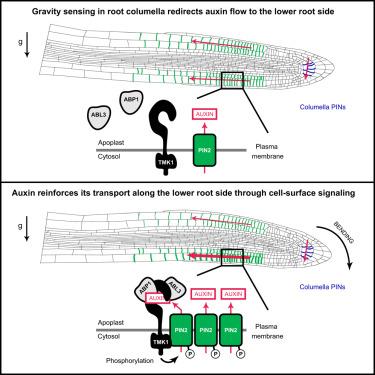ABP1/ABL3-TMK1细胞表面生长素信号通路以pin2介导的生长素通量为目标
IF 42.5
1区 生物学
Q1 BIOCHEMISTRY & MOLECULAR BIOLOGY
引用次数: 0
摘要
植物激素生长素及其定向运输介导了许多高等植物的显著可塑性发育。生长素信号和运输之间的正反馈是(1)自组织过程(包括维管组织形成)和(2)定向生长反应(如向地性)的先决条件。在这里,我们确定了生长素信号直接靶向PIN生长素转运蛋白的机制。生长素通过细胞表面生长素结合蛋白1 (ABP1)-跨膜激酶1 (TMK1)受体模块,快速诱导磷酸化,从而稳定PIN2。在重力刺激后,最初的生长素不对称激活TMK1激酶的自磷酸化。这诱导了TMK1与PIN2的相互作用和磷酸化,稳定了PIN2在下根侧,从而加强了不对称的生长素流动,导致根弯曲。在TMK1的上游,ABP1冗余作用于根表达的ABP1- like 3 (ABL3)生长素受体。细胞表面生长素信号和pin介导的极性生长素运输之间的这种正反馈是强健的根向地性的基础,可能也是其他自组织发育现象的基础。本文章由计算机程序翻译,如有差异,请以英文原文为准。

ABP1/ABL3-TMK1 cell-surface auxin signaling targets PIN2-mediated auxin fluxes for root gravitropism
Phytohormone auxin and its directional transport mediate much of the remarkably plastic development of higher plants. Positive feedback between auxin signaling and transport is a prerequisite for (1) self-organizing processes, including vascular tissue formation, and (2) directional growth responses such as gravitropism. Here, we identify a mechanism by which auxin signaling directly targets PIN auxin transporters. Via the cell-surface AUXIN-BINDING PROTEIN1 (ABP1)-TRANSMEMBRANE KINASE 1 (TMK1) receptor module, auxin rapidly induces phosphorylation and thus stabilization of PIN2. Following gravistimulation, initial auxin asymmetry activates autophosphorylation of the TMK1 kinase. This induces TMK1 interaction with and phosphorylation of PIN2, stabilizing PIN2 at the lower root side, thus reinforcing asymmetric auxin flow for root bending. Upstream of TMK1 in this regulation, ABP1 acts redundantly with the root-expressed ABP1-LIKE 3 (ABL3) auxin receptor. Such positive feedback between cell-surface auxin signaling and PIN-mediated polar auxin transport is fundamental for robust root gravitropism and presumably for other self-organizing developmental phenomena.
求助全文
通过发布文献求助,成功后即可免费获取论文全文。
去求助
来源期刊

Cell
生物-生化与分子生物学
CiteScore
110.00
自引率
0.80%
发文量
396
审稿时长
2 months
期刊介绍:
Cells is an international, peer-reviewed, open access journal that focuses on cell biology, molecular biology, and biophysics. It is affiliated with several societies, including the Spanish Society for Biochemistry and Molecular Biology (SEBBM), Nordic Autophagy Society (NAS), Spanish Society of Hematology and Hemotherapy (SEHH), and Society for Regenerative Medicine (Russian Federation) (RPO).
The journal publishes research findings of significant importance in various areas of experimental biology, such as cell biology, molecular biology, neuroscience, immunology, virology, microbiology, cancer, human genetics, systems biology, signaling, and disease mechanisms and therapeutics. The primary criterion for considering papers is whether the results contribute to significant conceptual advances or raise thought-provoking questions and hypotheses related to interesting and important biological inquiries.
In addition to primary research articles presented in four formats, Cells also features review and opinion articles in its "leading edge" section, discussing recent research advancements and topics of interest to its wide readership.
 求助内容:
求助内容: 应助结果提醒方式:
应助结果提醒方式:


